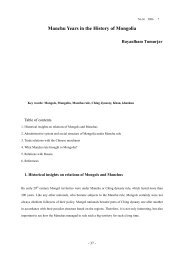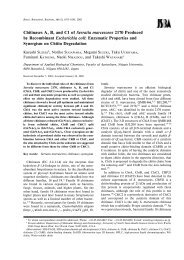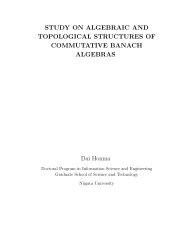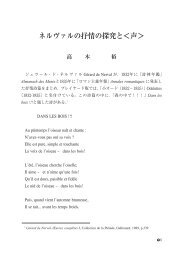An Overview of the Albanian History:
An Overview of the Albanian History:
An Overview of the Albanian History:
Create successful ePaper yourself
Turn your PDF publications into a flip-book with our unique Google optimized e-Paper software.
No.34 2005 12 <br />
and <strong>the</strong> province's majority ethnic <strong>Albanian</strong> population. It is a part <strong>of</strong> Serbia, but since <strong>the</strong> Kosovo War (1996-1999) it<br />
has been administered by <strong>the</strong> United Nations as a protectorate. Its <strong>Albanian</strong> population referred to <strong>the</strong> province as <strong>the</strong><br />
Republic <strong>of</strong> Kosovo between 1990 and 1999 and declared it an independent state, though this was recognized abroad<br />
only by Albania. The province's final status has yet to be determined; talks on this issue are scheduled for later in 2005.<br />
(http://en.wikipwedia.org/wiki/Albania, 2005/07/08).<br />
4 The Republic <strong>of</strong> Serbia (Serbian: Република Србија, Republika Srbija) is a republic in South-eastern Europe, which is<br />
united with Montenegro in a loose commonwealth known as <strong>the</strong> State Union <strong>of</strong> Serbia and Montenegro. The roots <strong>of</strong> <strong>the</strong><br />
Serbian state reach back to <strong>the</strong> first half <strong>of</strong> <strong>the</strong> 9th century. The Kingdom <strong>of</strong> Serbia was established in <strong>the</strong> 11th century,<br />
and in <strong>the</strong> 13th century it eventually became <strong>the</strong> Serbian Empire. After 1918, Serbia was a founding member <strong>of</strong><br />
Yugoslavia in its various forms (<strong>the</strong> Kingdom <strong>of</strong> Yugoslavia, <strong>the</strong> Socialist Federal Republic <strong>of</strong> Yugoslavia, and <strong>the</strong><br />
Federal Republic <strong>of</strong> Yugoslavia). (http://en.wikipwedia.org/wiki/Albania, 2005/07/08).<br />
5 The Republic <strong>of</strong> Macedonia is an independent state on <strong>the</strong> Balkan Peninsula in sou<strong>the</strong>astern Europe. Most nations and<br />
international organizations recognize <strong>the</strong> country as <strong>the</strong> Former Yugoslav Republic <strong>of</strong> Macedonia (FYROM), <strong>the</strong> name<br />
under which it was admitted into <strong>the</strong> United Nations but many countries, including China, Russia, and <strong>the</strong> United States<br />
<strong>of</strong>ficially recognize it under <strong>the</strong> name it uses for itself. It is <strong>of</strong>ten called simply Macedonia, although this can cause<br />
confusion with <strong>the</strong> Greek region <strong>of</strong> Macedonia and <strong>the</strong> wider geographical region (http://en.wikipwedia.org/wiki/Albania,<br />
2005/07/08).<br />
6 The Adriatic Sea is an arm <strong>of</strong> <strong>the</strong> Mediterranean Sea separating <strong>the</strong> Apennine peninsula (Italy) from <strong>the</strong> Balkan<br />
Peninsula, and <strong>the</strong> system <strong>of</strong> <strong>the</strong> Apennine Mountains from that <strong>of</strong> <strong>the</strong> Dinaric Alps and adjacent ranges.<br />
The western coast is Italian, while <strong>the</strong> eastern coast runs along <strong>the</strong> countries <strong>of</strong> Slovenia, Croatia, Bosnia and<br />
Herzegovina, Montenegro, and Albania (http://en.wikipwedia.org/wiki/Albania, 2005/07/08).<br />
7 The Ionian Sea is an arm <strong>of</strong> <strong>the</strong> Mediterranean Sea, south <strong>of</strong> <strong>the</strong> Adriatic Sea. It is bounded by sou<strong>the</strong>rn Italy, including<br />
Calabria and Sicily, to <strong>the</strong> west, by southwestern Albania and a large number <strong>of</strong> Greek islands. The islands are<br />
collectively referred to as <strong>the</strong> Ionian Islands. The sea is one <strong>of</strong> <strong>the</strong> most seismic areas in <strong>the</strong> world.<br />
8 http://en.wikipwedia.org/wiki/Albania, 2005/07/08).<br />
9 “Epirus” means “mainland” or “continent” in Greek, and was originally applied to <strong>the</strong> whole coast northward <strong>of</strong> <strong>the</strong><br />
Corinthian Gulf in contradistinction to <strong>the</strong> neighboring islands, Corfu (Corcyra), Leucas, etc. In consequence it does<br />
have not any ethnical meaning, as it is sometimes proclaimed. The name <strong>of</strong> Epirus, as applied to Sou<strong>the</strong>rn Albania, is<br />
misleading inasmuch as its Greek sound gives <strong>the</strong> idea that one is dealing with a Greek territory. This is due to <strong>the</strong><br />
unfortunate fact that <strong>the</strong> principal sources <strong>of</strong> <strong>the</strong> history <strong>of</strong> this section <strong>of</strong> Albania are <strong>the</strong> writings <strong>of</strong> Greek historians,<br />
some <strong>of</strong> whom tend to Hellenize everything. Yet, all <strong>the</strong> ancient Greek writers, including Theopompus, Thucydides, and<br />
<strong>the</strong> more modern Plutarch, are in full accord in stating that Epirus was exclusively inhabited by non-Hellenic barbarous<br />
populations. http://en.wikipwedia.org/wiki/Albania, 2005/07/08).<br />
10 http://www.opic.gov/links. 2005/08/18<br />
11 Gjergj Kastrioti (George Kastrioti) (1405, Kruja - January 17, 1468, Lezha), better known as Skanderbeg, is <strong>the</strong> most<br />
prominent figure in <strong>the</strong> history <strong>of</strong> Albania. He was a descendant <strong>of</strong> <strong>the</strong> Kastrioti family, a respected family <strong>of</strong> princes in<br />
Albania. Obliged by <strong>the</strong> Ottomans to pay tribute to <strong>the</strong> Empire, and to ensure <strong>the</strong> fidelity <strong>of</strong> local rulers, Gjon Kastrioti's<br />
sons were taken by <strong>the</strong> Sultan to his court. In 1423, Gjergj Kastrioti and his three bro<strong>the</strong>rs were thus taken by <strong>the</strong> Turks.<br />
He attended military school and led many battles for <strong>the</strong> Ottoman Empire to victory. For his military victories, he<br />
received <strong>the</strong> title Iskander Bey Arnauti, (<strong>Albanian</strong>: Skënderbeu Shqiptari, English: Skanderbeg, <strong>the</strong> <strong>Albanian</strong>). In<br />
Turkish this title means Lord Alexander, comparing Kastrioti's military brilliance to that <strong>of</strong> Alexander <strong>the</strong> Great.<br />
Skanderbeg soon switched sides and came back to his native land to successfully defend Albania against <strong>the</strong> Ottoman<br />
Empire until <strong>the</strong> time <strong>of</strong> his death.<br />
12 The ecclesiastical record <strong>of</strong> <strong>the</strong> ninth century mentioned Kruja as a bishop's see. The Byzantine held <strong>the</strong> city up to<br />
c.1190, when <strong>the</strong> first <strong>Albanian</strong> feudal state was declared at Kruja under <strong>the</strong> archon Progon (1190-8). Albania survived<br />
throughout <strong>the</strong> rule <strong>of</strong> Progon's son Gjin (1198-1206) and Dhimitrit (1206-16), but in 1216 it fell under <strong>the</strong> sway <strong>of</strong><br />
Epiros, in 1230 under Bulgarians, and in 1240 again under Epiros. Foreign invaders continue to fight over <strong>the</strong> dying<br />
body <strong>of</strong> a torn and bleeding Albania until an Ottoman garrison was permanently stationed at Kruja in 1415. The citadel<br />
<strong>of</strong> Kruja became <strong>the</strong> scene <strong>of</strong> one <strong>of</strong> Europe's most titanic struggles. In May 1450 <strong>the</strong> Ottoman Sultan Murad II set out<br />
from Constantinople with a hundred thousand men to crush once and for all <strong>the</strong> <strong>Albanian</strong> army, which had been united<br />
since 1444 by Skenderbeg's personal recruiting campaign. He aimed to storm <strong>the</strong> citadel <strong>of</strong> Kruja and to hold <strong>the</strong><br />
<strong>Albanian</strong> countryside with Kruja as a capital. http://www.albanian.com/information/countries/albania/kruja/index.html,<br />
2005,9,06<br />
13 Prizren is a city <strong>of</strong> Kosovo and has about 70.000 inhabitants.<br />
14 The League <strong>of</strong> Prizren (<strong>Albanian</strong>: Lidhja e Prizrenit) was created on June 10, 1878 in a mosque in Prizren, Kosovo by<br />
300 <strong>Albanian</strong> nationalist leaders, mostly from Kosovo, Western former Yugoslav Republic <strong>of</strong> Macedonia, and Muslim<br />
leaders from Bosnia-Hercegovina and <strong>the</strong> Sandzak, in order to achieve an autonomous <strong>Albanian</strong> state, representing <strong>the</strong><br />
former Ottoman vilayets <strong>of</strong> Shkodër or Skutari centered near Montenegro, <strong>the</strong> Illyria region, <strong>the</strong> Chameria region, Janina<br />
or Janjevo centered in Nor<strong>the</strong>rn Epirus, Bitola in Republic <strong>of</strong> Macedonia and Kosovo. The League was <strong>the</strong> first major<br />
attempt to create a unified <strong>Albanian</strong> region since <strong>the</strong> Middle Ages when <strong>Albanian</strong> forces under Gjergj Kastrioti,<br />
Skanderbeg, had failed. Historia e Popullit Shqiptar, 2000, (<strong>History</strong> <strong>of</strong> Albania, 2000)<br />
- 263 -







